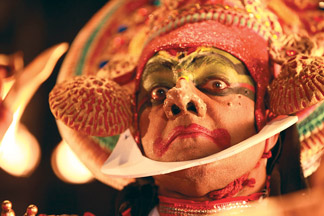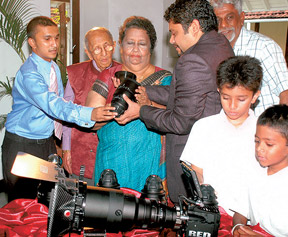|

All in the name of love
Ruwini JAYAWARDANA
|

Senior Professor Sunil Ariyaratne. Picture by Lalith C Gamage |
It’s not every day that you get to work in a film like ‘Kusa Paba’,
says Pooja Umashankar. A well-written script and a Director with focus
and clarity do not often come together.
Veteran film Director Senior Professor Sunil Ariyaratne’s ‘Kusa Paba’
has been hitting the headlines of newspapers ever since its
announcement.
The movie stars seasoned actor Jackson Anthony and Pooja Umashankar
in lead roles. Many popular faces adorn the movie: Ravindra Randeniya,
Chandani Seneviratne, Veena Jayakody, Palitha Silva, Kusum Renu, Roshan
Ranawana, Mahendra Perera, Mahinda Pathirage, Gamini Jayalath, Ariyasena
Kaluwarachchi, Dimuthu Chinthaka, Dhanawardena Guruge, Harsha Sirimanna,
Ranjith Dissanayake, Krishantha Erandaka, Bakthi Mendis and many others.
Based on the 523rd story (Kusa Jataka) in the Jataka story series,
the film portrays the defiance of Pabhavathi towards Kusa once she
discovers his grotesque looks. The movie is the first production of the
Sri Lanka Cinema Creations Foundation which is made up of many renowned
producers and directors. It will be screening at 50 theaters belonging
to the EAP, MPI and Rithma circuits from January 26.
Q: Many artistes like King
Parakramabahu (Kav Silumina), Alagiyavanna Mukavati (Kusa Jataka Kavya)
John Mertheenuss Pavulas Pieries Samarasinghe Sriwardena (Kusa Nadagama),
John de Silva (Kusa Jahtaka Drushya Kavya) and Prof Ediriweera
Sarachchandra (Pabavathi) have based the 'Kusa Jataka’ for their
productions. They portray Pabavathi's nature in a more sympathetic angle
than that of the cruel woman in the Jataka tale. What is your take on
Pabavathi?
A: The Buddha related this
Jataka tale because he wanted to stress on the fact that females are an
unfortunate set of beings. The reason he told the story was because a
bhikku had seen a beautiful woman and had lusted after her. The Buddha
revealed that he too had been blinded by beauty in one of his previous
births. Any educated, headstrong man will face destruction if he is
overcome by lust.

King Kusa masters the art of pottery |

Jackson as Kusa |

Palitha and Kusum |
However critics say that the Buddha could not have made such a point
because he brought justice for women.
Therefore some of them had altered the ‘Kusa Jataka’ to tone down
Pabavathi’s cruel behaviour. She was stubborn and snobbish due to her
incomparable beauty. She had addressed Kusa with many names like
‘monkey’ and had told him to find someone equally ugly because she does
not wish to share her life with him.
The original Jataka does not tell any positive characteristics
related to Pabavathi. Therefore some writers in the 13th century altered
the tale so that the readers will look at the princess with a
sympathetic eye. These indicate that Pabavathi’s obstinate manners were
a result of queen Seelavathi’s deception.
Seelavathi plotted to bring the teenage princess and Kusa together so
that they will meet only during night time. This was to ensure that they
can produce a child as an heir to the throne. This was stressful to
Pabavathi who yearned to catch a glimpse of her husband’s face.
King Parakramabahu did not point out straight that this was the
reason why Pabavathi rebelled against her marriage. He merely worded the
poems in a manner so that this picture too is painted in the reader’s
mind.
Prof Sarachchandra too looked at Pabavathi’s dilemma with compassion.
Dr Tissa Abeysekara wrote the script of the film to project the good and
bad aspects of Pabavathi. Kusa too has his plus and weak points just
like any other human being. These are brought out in the film as well.
Dr Abeysekara had paid special attention in building up Pabavathi’s
character. It is similar to the picture depicted in ‘Kav Silumina’ but
he had etched it in a manner so that there is a more vivid portrayal of
the princess. She gains the compassion from the audience rather than
their wrath.
Q: You have done historic movies
before when you did 'Kristhu Charithaya' and 'Sudu Sevanali'. What kind
of new experience did making 'Kusa Paba' offer you?
A: One of the reasons that
directors do not engage in making movies based on history is because
they demand huge sets.
It is very difficult to do outdoor shooting because landscapes have
been modernized. You cannot show people walking on a road layered with
tar or antennas on buildings in the horizon. It is very difficult to
avoid these elements. I faced these challenges to a certain extent in my
previous movies.
‘Kusa Paba’ differed from them not only because it goes decades back
even before Christ but also because the setup is based in India.
We were careful in selecting the costumes and the background for the
scenes. Our biggest challenge was finding a place to build the sets.
Asoka, Sri Lanka biggest studio, was destroyed during the 1983 ethnic
conflict. This is a real tragedy because we lost a venue where we could
have built big sets for movies. Luckily the Ranmihithenna studio was
available and ‘Kusa Paba’ became the first film to be shot there. We
shot around 99 percent of the indoor scenes in Ranmihithenna.
Q: Did your experience of making 'Kristhu
Charithaya' and 'Sudu Sevanali' help you in directing ‘Kusa Paba’?
A: Definitely. I would
have made 'Kristhu Charithaya' in a different manner had I done it
today. We had a lot of problems when we did the movie. Vijaya
Kumaratunge acted the lead and the prevailing government of the time
believed that the role would have been advantageous for him in a
political sense. They banned the movie from being shot for several
years. I would have made a much better production with certain changes
if I got the opportunity to make the movie today.
Q: How is the moral theme of the
‘Kusa Paba’ relevant to the present society?
A: The best texts in the
world are the ‘550 Jataka Stories’ and the ‘Bible’. Any educated man or
woman needs to read these texts because the stories are timeless. They
comprise deep themes and humane ideologies.
‘Kusa Paba’ projects sacrifices people make in the name of love. This
is not limited to any ethnic group, class educational status or age. The
main aspect of this story is eroticism. It is a tale of two lovers.
If you look at the story from the Buddha’s aspect, people suffer due
to love and lust. These experiences are common to the contemporary
youth.
Q: What was the most difficult scene
to shoot?
A: It was the climax of
the film where there were seven elephants, five horses, around 1000
extras and many actors. We had artificial rain and thunder for the
finale. We shot the scenes for a continuous five days and using two
cameras: one imported from India and the other owned by Dilmon Jayaratne.
Another difficult scene is the ‘Madhura Wasanthaya’ dance item. We had
50 drummers and hundreds of dancers in the background.
Q: 'Kusa Paba' is a collaborative
effort by the Sri Lanka Cinema Creations Foundation.
A: This is the first time
in our history that so many veteran producers and directors were working
on one set.
There were some directors who were more experienced than me, who had
bagged awards more than me and who had profited from films more than me
but they did not come to meddle with my work at any stage.
They supported me tremendously. It is four years since this script
had been written. I was unable to find a producer to fund the project.
Had it not been for their strength, I would not have been able to make
this movie.
Sumitra begins work on ‘Vaishnavee’
Ruwini Jayawardana
Season film-maker Sumitra Peries began work on her much awaited
production ‘Vaishnavee’ on January 10 as she joined hands with Asia
Digital Entertainment.
|

Yashodha, Sumitra, Dr Lester, Manohan, Lalinka and Thumindu‘‘ |
The script of the movie is based on a story penned by Dr Lester James
Peries and scripted by Tony Ranasinghe. Expected to be a trailblazer in
the Sri Lankan cinema industry, ‘Vaishnavee’ is a story revolving around
a puppet that has fantastically come to life. It is a fantasy genre
movie which demands technologically advanced special effects. Therefore
it will be shot using the Red Epic 5K, one of the most advanced digital
cameras. This will be the first time that the Red Epic is used to shoot
a Sri Lankan movie production. “This is be a momentous moment for Lester
and me. The concept for the film had been with us for many years but we
never got the chance to put it into motion. This is the first time that
we are venturing out with the new technology. I am a little intimidated
but the adventurous streak has not left me yet,” Sumitra said adding
that she hopes that the industry will be rejuvenated with the new
technology.
Speaking at the muhurath ceremony Asia Digital Entertainment Chief
Operating Officer Lalinka Muthukumarana said that Dr Lester James Peries
and Sumitra Peries are the figures who created Sri Lankan cinema.
|

Dr Lester, Sumitra and Vishwa with the Red Epic 5K
Pictures by Nissanka Wijeratne |
“In 1956 ‘Rekawa’ was the first Sri Lankan movie that was produced
entirely within the country. It is considered the first 100 percent Sri
Lankan-made movie. That is why we thought of inviting Dr. and Mrs.
Peries to play such a pivotal role in the recreation and evolution of
the Sri Lankan cinema industry towards digital technology,” he said.
The Red Epic camera manufactured under the brand name Red is a highly
advanced digital camera produced in the USA. The founder of the Red line
of cameras, Jim Jinnard, created it with the focus of introducing the
most advanced digital camera in the world.
The Red Epic comprises a list of endless features, enabling the
camera to capture up to 120 frames per second, each frame at full 14MP
resolution and capturing at 5K. The Red Epic has been used in a number
of leading movies in Hollywood, including ‘Pirates of the Caribbean’,
‘Angels and Demons’, ‘The Hobbit’ and ‘The Girl with the Dragon Tattoo’.
Asia Digital Entertainment has exclusively trained cinematographer
Vishwa Balasuriya at the RED Studios in Hollywood to operate the Red
Epic. He is also capable of training others to use the camera.
Popular actress Yashodha Wimaladharma will ignite the screen again in
‘Viashnavee’. Thumindu Dodanthenna will take on the lead male role.
Shehara Hawadewa will debut to cinema through the movie. Acclaimed
cinematographer Donald Karunarathe will be the director of photography
for the project. ‘Vaishnavee’ will be produced by Manohan Nanayakkara.
SAARC Film Day
|

A scene from ‘The Kite Runner’ |
The SAARC Cultural Centre (SCC), Colombo, has decided to screen
movies from each of its member countries in an attempt to bring member
states of the SAARC region together embracing culture and recognizing
unity through diversity.
'The Kite Runner', a Marc Forster film based in Afghanistan will be
the first of many films to be screened for SAARC Day. 'The Kite Runner'
will unspool at the National Film Corporation cinema hall on January 23
at 6.30 pm. This movie is a fascinating historic epic, set in the 20th
century Afghanistan in 1978. It is based on Khaled Hosseini’s book with
a globally diverse cast and crew, mixing a remarkable group of non
actors from Afghanistan. SAARC is an association established for
corporation between South Asian Countries. Afghanistan, Bangladesh,
Bhutan, India, Maldives, Nepal, Pakistan and Sri Lanka are the current
members of SAARC. It is a regional centre established based on the
decision made by the heads of state or governments of SAARC countries to
promote cultural cooperation in order to bring the people of South Asia
closer and to project the distinct identity of South Asia.
The centre is intended to function as a major meeting point for the
artistic communities of the member States. The Centre will provide the
necessary facilities and conditions for individuals and groups in
various fields of interest to meet and interact in a conducive
environment. It is intended to cater to all forms of art such as
performing arts (e.g., dance, music, drama, theatre, puppetry and folk
culture), visual art (e.g., painting, sculpture, film making,
photography) and literature.
‘Players’: a wild combination
 If
the plot about stealing a mind-boggling amount of gold bullion by
creating a monumental traffic jam sounds familiar, that's because it was
the basis of Michael Caine's finest hour in ‘The Italian Job’ (1969). If
the plot about stealing a mind-boggling amount of gold bullion by
creating a monumental traffic jam sounds familiar, that's because it was
the basis of Michael Caine's finest hour in ‘The Italian Job’ (1969).
F Gary Gray remade ‘The Italian Job’ in 2003, moving the story from
the streets of Turin to Los Angeles and putting Mark Wahlberg in the
lead role. As far as remakes go, it wasn't half bad.
Now it's Bollywood's turn to put a spin on the original Troy
Kennedy-Martin script. Although Abhishek Bachchan is not quite up to the
standard of Caine, the troupe pull off their own remarkable heist,
making ‘Players’ a bigger, larger and more fun version of the tale. It's
also a curiosity that what started out as a lean 99-minute British heist
movie became a 111-minute Hollywood blockbuster and is now an almost
three-hour flick to Hindi cinema. ‘Players’ will begin screening at
Liberty cinema from January 26. |



